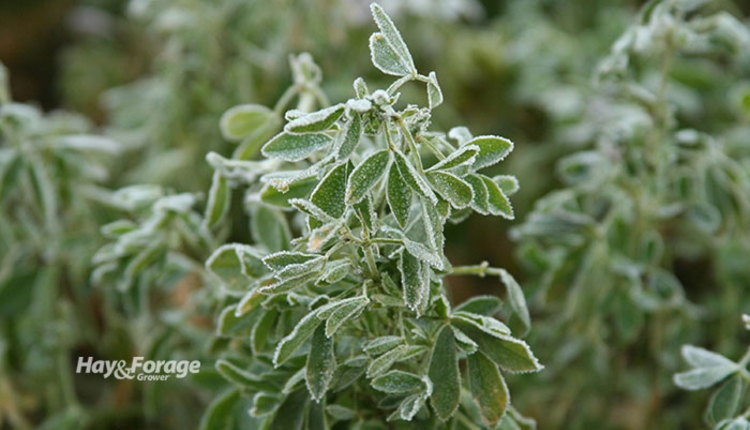
We’ve already heard some reports of frost- and freeze-damaged alfalfa this spring. More will likely come. Although regional, frost or freeze-induced injury to alfalfa seems to occur every year.
Frost damage to alfalfa usually varies across a field and hinges on the microclimate near the soil surface. It generally takes several days following the frost to assess the extent of plant damage. Immediately after a frost, it’s difficult to discern the extent of permanent damage in the form of dead plant tissue.
The University of Kentucky has a helpful publication on evaluating frost- and freeze-damaged alfalfa. It offers the following guidelines and follow-up strategies when evaluating alfalfa fields following a frost or freeze event.
Established stands:
Light frost with temperatures in the range of 27°F to 31°F:
Leaves may be impacted, and some twisting of stem ends may occur when temperatures drop below 28°F. Buds and growing points are rarely damaged. Alfalfa will normally outgrow this damage, and no changes in management practices are warranted.
Moderate frost with canopy temperatures in the range of 26°F to 27°F:
Freezing causes significant injury in the terminal growing point near the end of the stem; however, the entire stem is not killed. Axillary and crown buds begin to develop into new stems. The lower stems, not impacted by frost, will continue to grow normally; this results in a mixture of mature and vegetative growth that makes harvest decisions difficult. Avoid cutting moderately frosted alfalfa early since the stress of early cutting reduces both yield and regrowth rate.
Severe frost with canopy temperatures below 26°F for extended periods:
Stems that were growing at the time of frost will not regrow. Regrowth comes from crown buds at the base of the plant. Following a severe killing frost, immediately cut alfalfa stands with sufficient growth to justify a harvest; this helps to maintain forage quality and allows regrowth from crown buds.
When stands are short, frost-damaged plant material can be left in place; this may delay but will not inhibit new regrowth. Severe frost-damaged plants can be grazed off. Waiting for frosted alfalfa to begin to dry will significantly reduce the chances of bloat. Since severe frost has the same effect on alfalfa as an early harvest, regrowth will likely be slower. Delay second harvest a week or more to allow the plant to recover its stored carbohydrates.
New alfalfa seedings:
Immediately after emergence, alfalfa seedlings have fair to good tolerance to cold injury. Once they reach the second trifoliate leaf stage, tolerance to cold injury declines markedly. Four or more hours of exposure to 26°F can kill seedlings at this growth stage.
Before reseeding, assess the damage in new stands. The ideal stand density at the end of the first production year is 12 to 20 plants per square foot. If this number of healthy seedlings per square foot is present following frost damage, then no reseeding is needed. If stands do not consistently have 12 to 20 healthy plants per square foot, then thickening stands with a no-till seeder may be the best option. In most cases, seeding rates in the range of 10 to 12 pounds per acre should be sufficient for thickening frost-damaged stands.

